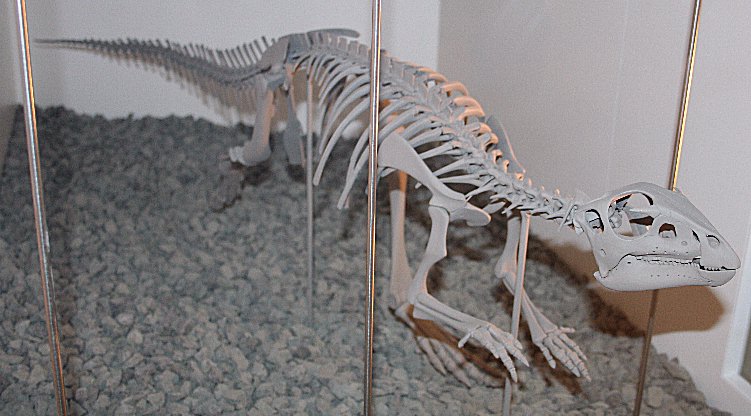- Hypsilophodon
Taxobox
name = "Hypsilophodon"
fossil_range =Early Cretaceous

image_caption = Mounted replica,Melbourne Museum .
regnum =Animal ia
phylum = Chordata
classis =Sauropsida
superordo =Dinosaur ia
ordo =Ornithischia
subordo =Cerapoda
infraordo =Ornithopoda
familia =Hypsilophodont idae
genus = "Hypsilophodon"
binomial = "Hypsilophodon foxii"
binomial_authority = Huxley,1869 "Hypsilophodon" (pronEng|ˌhɪpsɨˈlɒfoʊdɒn; meaning 'high-crested tooth') is an
ornithopod dinosaur genus from the EarlyCretaceous Period ofEurope . It was a smallbiped al animal with an herbivorous or possibly omnivorous diet. Abundantfossil remains found inEngland indicate that "Hypsilophodon" reached about 2meter s (6.5 feet) in length.Discoveries and species
The first remains of "Hypsilophodon" were recovered in the early days of
paleontology in 1849. However, at the time, the bones were thought to belong to a young "Iguanodon ". It was not until 1870 that paleontologist T. H. Huxley was able to publish a full description of "Hypsilophodon" as we know it today. He had been provided with a number of skeletons by the ReverendWilliam Darwin Fox , after whom the first species of "Hypsilophodon" was named.Early paleontologists modeled the body of this small, bipedal, herbivorous dinosaur in various ways. In 1882 some paleontologists suggested that, like a modern
tree-kangaroo , "Hypsilophodon" was able to climb trees in order to seek shelter. This was the accepted view for almost a century. However, Peter M. Galton finally performed more accurate analysis of the musculo-skeletal structure in 1974 and convinced most paleontologists that "Hypsilophodon" remained firmly on the ground.Since then, three near-complete and over twenty minor finds have been made, especially on the Isle of Wight, off the south coast of
England . Other finds have been made in southern England andPortugal .Another misconception concerning the anatomy of "Hypsilophodon" was that it was armoured. The putative armour, consisting of thin mineralized plates from the torso, instead appear to be examples of intercostal plates associated with the rib cage. Such plates are better known from "
Talenkauen " and "Thescelosaurus ", and were were probably cartilaginous in origin.cite journal |last=Butler |first=Richard J. |coauthors=and Galton, Peter M. |date=2008 |title=The 'dermal armour' of the ornithopod dinosaur "Hypsilophodon" from the Wealden (Early Cretaceous: Barremian) of the Isle of Wight: a reappraisal |journal=Cretaceous Research |volume=29 |issue=4 |pages=636–642 |doi=10.1016/j.cretres.2008.02.002]There is only one known species of "Hypsilophodon", Huxley's original "H. foxii". Galton and Jensen named another species in 1979, "H. wielandi", which is based on a thigh bone from
South Dakota ,USA , but it is now regarded as an indeterminate basal ornithopod.cite book |last=Norman |first=David B. |authorlink=David B. Norman |coauthors=Sues, Hans-Dieter; Witmer, Larry M.; and Coria, Rodolfo A. |editor=Weishampel, David B.; Dodson, Peter; and Osmólska, Halszka (eds.)|title=The Dinosauria |edition=2nd |year= 2004|publisher=University of California Press |location=Berkeley |isbn=0-520-24209-2 |pages=393–412 |chapter=Basal Ornithopoda]Paleobiology
"Hypsilophodon" was a relatively small dinosaur. While not quite so small as, for example, "
Compsognathus ", "Hypsilophodon" was only around 2.3 metres in length. It would have reached approximately waist-height on a modern man and would have weighed about the same, at 50-70 kg.Like most small dinosaurs, "Hypsilophodon" was bipedal and ran on two legs. Its entire body was built for running; a light-weight, minimized skeleton, low,
aerodynamic posture, long legs and stiff tail for balance all would have allowed it to travel remarkably fast for its size.Due to its small size, "Hypsilophodon" fed on low-growing vegetation, most likely preferring young shoots and roots in the manner of modern
deer . The structure of its skull, with the teeth set far back into the jaw, strongly suggests that it had cheeks, an advanced feature that would have facilitated the chewing of food. There were twenty-eight to thirty ridged teeth in the animal's jaw which, due to their alternate arrangement, appear to have been self-sharpening. As in almost all dinosaurs and certainly all theornithischia ns, the teeth were continuously replaced.The level of parental care in this dinosaur has not been defined, although a neatly-arranged nest has been found, suggesting that some care was taken before hatching. Fossils of large groups have been found, so it is likely that the animals moved in
herd s. For these reasons, thehypsilophodont s, particularly "Hypsilophodon", have often been referred to as the "deer of the Mesozoic".Despite living in the last of the periods in which dinosaurs walked the earth, the Cretaceous, "Hypsilophodon" had a number of
primitive features. For example, there were fivedigit s on each 'hand' and four on each foot. Most dinosaurs had lost these redundant features by the Cretaceous period. Also, although it had a beak like mostornithischia ns, "Hypsilophodon" still had pointed triangular teeth in the front of the jaw. Most herbivorous dinosaurs had, by this stage, become sufficiently specialized that the front teeth had been altogether lost (although there is some debate as to whether these teeth may have had a specialized function in "Hypsilophodon").The group
Hypsilophodont ia remained remarkably static from the lateJurassic to the end of the Cretaceous. It is possible that this was because the animals were almost perfectly adapted to their lifestyle, therefore selective pressure, it is assumed, was low.References
*Parker, Steve. Dinosaurus. 1st edition. Buffalo, NY: Quintet Publishing Ltd., 2003.
External links
* [http://www.dinosaur.pref.fukui.jp/en/ddic/Hypsilophodon.html FPDM : Hypsilophodon foxii]
* [http://www.geocities.com/dinowight/hypsilophodon.html DinoWight - Hypsilophodon, an Isle of Wight Hypsilophodontid]
Wikimedia Foundation. 2010.
